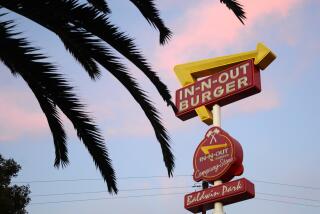Rise and fall of trans fat: A history of partially hydrogenated oil
- Share via
Trans fat was the first man-made fat to become part of our food supply more than a century ago when a German scientist presented Procter & Gamble with ways to add hydrogen to cottonseed oil. Because the product looked like lard (though originally intended for soap), P&G started selling it in 1911 as Crisco (the name derived from “crystallized cottonseed oil”).
And now, decades later, the Food and Drug Administration is moving to eliminate trans fats from the food supply. Most scientific research shows that even trace amounts can be harmful to health.
Partially hydrogenated oil (now also called trans fat) was an inexpensive substitute for butter and lard, and wow, did it make for flaky pie crust. It also increased the shelf life of baked goods and improved the texture of other foods. For decades, food manufacturers would add partially hydrogenated oil to cookies, crackers, bread, frozen foods and more, and food companies and restaurants used it for frying.
PHOTOS: Are you eating trans fats?
During the Great Depression and World War II, butter was in limited supply, and oleomargarine -- originally made with beef fat but by 1950 almost completely swapped for partly hydrogenated vegetable oils -- was widely used in its place.
In the late ‘50s, health advocates proposed reducing saturated fats, such as in butter and beef, from our diets, which propelled the use of margarine instead, a trend that snowballed in the 1980s. That’s when saturated-fat opponents also campaigned against beef fat and tropical oils for frying and fast-food companies responded by using partially hydrogenated oil instead. By 1993, the FDA required that saturated fat and cholesterol be listed on food labels.
But several studies conducted in the ‘90s showed a connection between trans fat and increased levels of bad cholesterol. A study at Harvard University reported that people who ate the highest amounts of trans fat had twice the heart-attack risk of those who consumed only a little. (Butter makes a comeback!)
PHOTOS: Are you eating trans fats?
In 1993, health advocacy groups called for fast food chains to stop frying with partially hydrogenated oil. It wasn’t until 10 years later that the FDA required trans fat to be listed on food nutritional labels (giving food companies until 2006 to comply) along with saturated fat and cholesterol.
Many manufacturers have since reformulated their products to remove trans fat, including Crisco.
ALSO:
FDA moves to ban trans fat from processed food
Buying a Thanksgiving turkey? Know what you’re getting
Jose Andres on the Bazaar expansion, Bazaar Meat and samurais in Spain
More to Read
Eat your way across L.A.
Get our weekly Tasting Notes newsletter for reviews, news and more.
You may occasionally receive promotional content from the Los Angeles Times.









